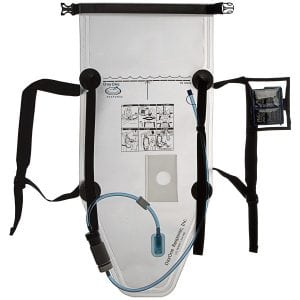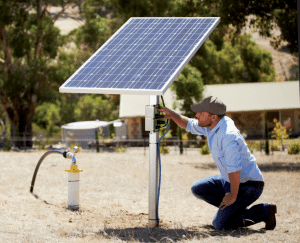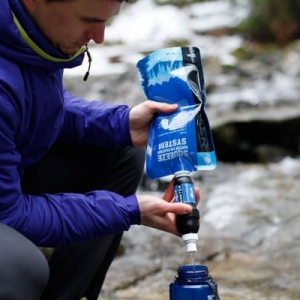
Agriculture
December 27, 2023
AquaFilter Family
Read SolutionImplemented by
Aquabox, UK

Updated on August 16, 2024
·Created on October 5, 2020
The Aerated Static Pile is a composting method that transforms municipal organic waste into a marketable product.
The Aerated Static Pile is a modular composting technology for biological stabilisation of municipal organic waste under a controlled environment. The design can be used for over 500 kg of organic waste, with minimal leachate, to produce a soil enhancer for agricultural fields, gardens, and/or forest land. The process decreases the composting cycle time, is space-efficient, and can be used in cold climates.
Target SDGs
SDG 6: Clean Water and Sanitation
Market Suggested Retail Price
$1,212.00
Target Users (Target Impact Group)
Community, Small and Medium-sized Enterprises, Public Sector Agencies, NGOs
Distributors / Implementing Organizations
This technology is available as open-source but can also be acquired from organisations in India and the USA.
Competitive Landscape
Direct competitors include Rotary Drum Composting, Vermicomposting, and NADEP Composting.
Regions
Worldwide
Manufacturing/Building Method
The Aerated Static Pile is built on site which can be designed for large scale industrial compositing systems or for smaller scale operations.
Intellectural Property Type
Open-source
User Provision Model
This product can be constructed by the users or by contacting retailers.
Distributions to Date Status
Due to the open-source nature of this technology, the distributions to date are unknown.
Input requirement (volume and frequency)
500 kg and above
20% food scraps, 40% wood chip, 20% cow manure, 20% horse manure
Carbon: Nitrogen Ratio of 25-30:1
Additives
Wood chips
Production capacity (kg output per kg input)
0.5 to 0.67 kg output per kg input before screening. Can reduce down to 0.3 to 0.4 kg output after screening.
Production duration
30 to 60 days for finished bulk product, up to 6 months curing for a bagged product.
Percentage of nutrient recovery
Up to 60 % Nitrogen:50 % Carbon
Complementary treatment needed
None
Design Specifications
Aerated Static Pile is composting with airflow introduced into the composting system to control pile temperatures in order to yield high-quality compost that is effectively free of pathogens, parasites and weed seeds. Through this process, offensive odours and flies are controlled. This consists of five components.
Technical Support
There is no technical support provided as users are expected to maintain the product on their own.
Replacement Components
Replacement components include additives such as wood chips and the feedstock material to be composted.
Lifecycle
The lifecycle of the Aerated Static Pile is the time it takes for feedstock to be composted, approximately 30 to 60 days for a bulk product. The process can then be repeated for future composting products.
Manufacturer Specified Performance Parameters
Performance targets of the Aerated Static Pile include:
Vetted Performance Status
Testing by the University of Leeds evaluated hybrid Aerated Static Piles (suck and blow aeration) compared to sole blow aeration. Hybrid piles produced higher and even temperatures through the pile and increased pathogen inactivation compared to solely blow aeration. Hybrid piles presented higher sanitization due to the high temperatures but lower microbial activity and compost stability the the blow piles in the initial stages of composting.
Safety
Offensive odours must be controlled during the process through a thick bio layer. Monitoring the temperature is essential to ensure efficient eradication of faecal coliforms and salmonella bacteria while achieving a high quality composting product.
Complementary Technical Systems
The Aerated Static Pile can be extended as it is a modular system. Organic product can be used for agricultural fields, gardens and forest land soil enhancers.
Academic Research and References
Sikora, L. J., et al., 1981, Materials Balance in Aerated Static Pile Composting, Journal (Water Pollution Control Federation) 53: 1702-1707.
Robinson, J. J., Stentiford, E. I., 1993, Improving the aerated static pile composting method by the incorporation of moisture control, Compost Science & Utilization 1: 52-68
Sesay, A. A., Lasaridi, K.E., Stentiford, E. I., 1998, Aerated static pile composting of municipal solid waste (MSW): a comparison of positive pressure aeration with hybrid positive and negative aeration, Waste Management & Research 16: 264-272.
Notton, D., 2005, “Theoretical and experimental determination of key operating parameters for composting systems,” Ph.D. dissertation, Cardiff University, Cardiff, UK.
Isobaev, P. et al., 2014, An enhanced compost temperature sampling framework: Case study of covered aerated static pile, Waste Management 34: 1117-1124.
Brodie, H. L., et al., 2013, A comparison of static pile and turned windrow methods for poultry litter compost production, Compost Science & Utilization 8: 178-189.
Ott, N., Paris, B., McSweeney, J., 2016, Testing an aerated static pile (ASP) compost system for efficiency of time and space, SARE (Sustainable Agriculture Research and Education).
Compliance with regulations
The composting industry has adopted criteria for all organic waste materials to ensure that finished compost products are safe for use. The technical term is “Process to Further Reduce Pathogens” (PFRP), covered under the U.S. Environmental Protection Agency (EPA) 40 CFR Part 503. To ensure:
Evaluation methods
Evaluation criteria for Aerated Static Piles include pile temperatures shall be maintained at 55oC (131oF) or higher for a minimum of 3 days, and a Carbon-to-Nitrogen ratio of 25-30:1.
Other Information
The product can also be acquired from organisations in India and the USA.
Aerated Static Pile Composting: An Introduction to ASP
Science direct - Composting

Agriculture
December 27, 2023
Implemented by
Aquabox, UK

Agriculture
January 11, 2024
Implemented by
Kenya Ceramic Project (KCP)

Agriculture
January 19, 2024
Implemented by
Clean Team Ghana

Agriculture
January 8, 2024
Implemented by
DayOne Response

Agriculture
December 20, 2023
Implemented by
SOIL Haiti

Agriculture
December 29, 2023
Implemented by
LifeStraw

Agriculture
December 27, 2023
Implemented by
Mono Pumps

Agriculture
October 14, 2023
Implemented by
P&G

Agriculture
August 17, 2024
Implemented by
Peepoople Kenya

Agriculture
December 29, 2023
Implemented by
Sawyer
Have thoughts on how we can improve?
Give Us Feedback